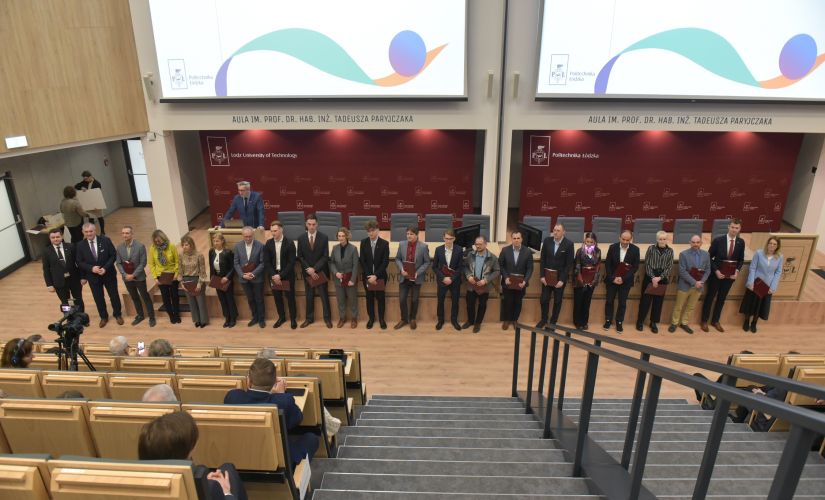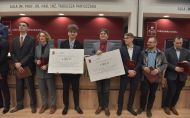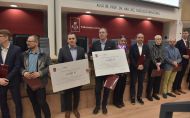On the opening day of the second edition of the Research Week, on March 11, the two best ones were announced.
The winners of the 2nd edition of E2TOP are Maciej Szulczewski, who carried out the project Robot pneumatyczny przeznaczony do diagnostyki układu pokarmowego człowieka [A Pneumatic robot for human gastrointestinal endoscopy] under the mentorship of dr inż. Łukasz Frącczak, and Wiktor Barańczyk, who worked on further development of the project Czy rozumiesz, co do Ciebie migam? [Do you understand what I'm signing to you?] under the mentorship of dr inż. Piotr Duch. Apart from congratulations, the students and their mentors were presented with token cheques of 6,000 złoty by the Rector of TUL, prof. Krzysztof Jóźwik.
To select the winners is not an easy job: the quality of the substantive content and the manner of its presentation were both very high. Each student was given 7 minutes to discuss their objectives, methodology, and outcomes. Admittedly, the enthusiasm and professionalism of the participants of the 2nd edition of the program, both with regard to the research and its public presentation, left no one in the audience unimpressed.
The students chose different fields and topics to work on: from using hydrogels to improve drug efficacy, to improving the safety of roof construction, to sustainable packaging. What they all emphasized, however, was the advantage of having the opportunity to collaborate with mentors, to pursue projects based on their interests and challenges that emerge in the process. Three of the participants have gone on international study visits and connected with the gathering at Alchemium via the Internet. This just goes to show that E2TOP fosters further growth of gifted students and opens international learning opportunities for them.
You can get to know the participants of the 2nd edition of the program by referring to the series of interviews available on the E2TOP website.
The program has been evolving to respond to the needs of students and thus, in its third edition, eligible to participate will also be students pursuing a master degree. A significant proportion of those qualified for the 2024/25 edition intend to continue their research projects.
Listed below are the participants in the 3rd edition of E2TOP (student name, research project title, mentor name):
First-year students:
- Kacper Frankowski, Czy klocki mogą machać ogonkiem? [Can building blocks wag their tails?], dr inż. Michał Lipian;
- Kacper Szeliga, Współczesne wyzwania w projektowaniu powłok polimerowych [Current challenges in polymer coating design], dr hab. inż. Anna Marzec, TUL prof.;
- Jowita Głosek, Wyłapane w sieci - chemia dla przemysłu i medycyny: hydrożel [Caught in a net(work): chemistry for manufacturing and medicine: hydrogels], prof. Marcin Kozanecki;
- Weronika Wiechno, AI Football Manager, dr inż. Piotr Duch
Second- and third-years students:
- Filip Barski, Odtworzenie oraz zbadanie wzmacniacza tarciowego Highama [Reproduction and testing of Highman friction amplifier], prof. Jerzy Wojewoda;
- Kornel Zawadzki, Baranek z dzwonkiem, czy byk z klamką? - aerodynamika kierownic rowerowych [A ram with a bell or a bull with a handle – aerodynamics of bicycle handlebars], dr inż. Michał Lipian;
- Maciej Szulczewski, Powłoki ochronne na potrzeby eksploracji księżycowej [Protective coatings for lunar exploration], dr inż. Marcin Makówka;
- Wiktor Barańczyk, Do you understand what I'm signing to you?, dr inż. Piotr Duch;
- Marek Darnowski, Energetyka przyszłości - dioda wysokiej mocy z zastosowaniem superzłącza [Power engineering for the future - high-power super-junction diode], dr inż. Jacek Podgórski;
- Julita Kostka, Modyfikacja powierzchni stopu tytanu fragmentami białek BMP i związkami kościotwórczym [Surface modification of titanium alloy with BMP protein fragments and bone-forming compounds], dr inż. Anna Jędrzejczak, prof. Beata Kolesińska;
- Małgorzata Mrozik, Zaprojektowanie i otrzymanie ekologicznych powłok polimerowych o właściwościach biostatycznych i ograniczonej palności [Designing and fabricating environmentally friendly biostatic and flame retardant polymer coatings], dr hab. inż. Anna Marzec, TUL prof.;
- Marta Kopytowska, Analizy teoretyczne, badania doświadczalne i modelowanie numeryczne różnych typów połączeń kalenicowych inspirowanych bioniką [Theoretical analysis, experimental research, and numerical modeling of different types of bio-inspired ridge connections], dr inż. Artur Wirowski;
- Agata Świetlik, EcoAI, dr inż. Arkadiusz Tomczyk.
The E2TOP program requires students to do solo research work under the guidance of a mentor of their choice. Participating students are provided with relevant support, i.e., access to research infrastructure, ongoing consultations with the mentor, a grant to purchase research materials, to attend conferences, and (2nd and 3rd year students) a scholarship of 10,000 złoty (disbursed monthly over a period of 10 months).
Master degree students qualified for the program will be announced shortly.



